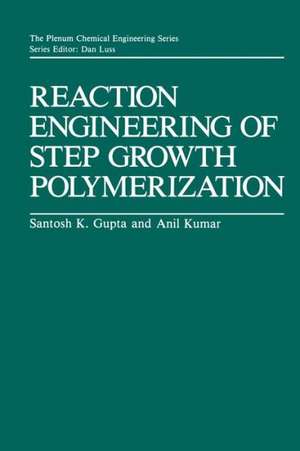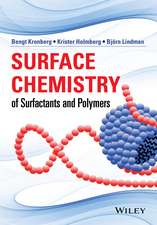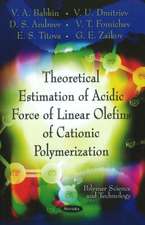Reaction Engineering of Step Growth Polymerization: The Plenum Chemical Engineering Series
Autor Santosh K. Gupta, Ajit Kumaren Limba Engleză Paperback – 21 dec 2011
Preț: 395.63 lei
Nou
Puncte Express: 593
Preț estimativ în valută:
75.72€ • 78.76$ • 63.46£
75.72€ • 78.76$ • 63.46£
Carte tipărită la comandă
Livrare economică 13-27 martie
Preluare comenzi: 021 569.72.76
Specificații
ISBN-13: 9781461290087
ISBN-10: 1461290082
Pagini: 448
Ilustrații: 444 p.
Dimensiuni: 152 x 229 x 24 mm
Greutate: 0.59 kg
Ediția:Softcover reprint of the original 1st ed. 1987
Editura: Springer Us
Colecția Springer
Seria The Plenum Chemical Engineering Series
Locul publicării:New York, NY, United States
ISBN-10: 1461290082
Pagini: 448
Ilustrații: 444 p.
Dimensiuni: 152 x 229 x 24 mm
Greutate: 0.59 kg
Ediția:Softcover reprint of the original 1st ed. 1987
Editura: Springer Us
Colecția Springer
Seria The Plenum Chemical Engineering Series
Locul publicării:New York, NY, United States
Public țintă
ResearchCuprins
1. Introduction.- 1.1. Step and Chain Growth Polymerizations.- 1.2. Step Growth Polymerization.- 1.3. Molecular Weight Distribution.- 1.4. Measurement of MWD and Its Moments.- 1.5. Types of Reactors.- 1.6. Conclusions.- References.- Exercises.- 2. Linear Step Growth Polymerization Following the Equal Reactivity Hypothesis.- 2.1. Introduction.- 2.2. Rate Constants for Elementary Step Growth Polymerization Reactions.- 2.3. Equal Reactivity Hypothesis.- 2.4. Kinetic Model of Irreversible Step Growth Polymerization under the Equal Reactivity Hypothesis.- 2.5. Experimental Verification of the Kinetic Model.- 2.6. Irreversible ARB Polymerizations with Monofunctional Compounds in Batch Reactors.- 2.7. Polymerization in Plug Flow Reactors (PFR) with Recycle.- 2.8. ARB Polymerization in Homogeneous Continuous-Flow Stirred Tank Reactors (HCSTRs).- 2.9. Reversible ARB Polymerization.- 2.10. Conclusions.- Appendix 2.1. Moment Generation Function.- References.- Exercises.- 3. Linear Step Growth Polymerization Violating the Equal Reactivity Hypothesis.- 3.1. Introduction.- 3.2. Irreversible ARB Polymerization with Oligomers Having Chain Length Dependent Reactivity.- 3.3. Reversible Step Growth Polymerization with Oligomers Having Chain Length Dependent Reactivity.- 3.4. Step Growth Polymerization Involving Asymmetric Functional Groups.- 3.5. Conclusions.- References.- Exercises.- 4. Nonlinear Step Growth Polymerization.- 4.1. Introduction.- 4.2. Average Molecular Weights and the Onset of Gelation in Batch Reactors.- 4.3. Postgel Properties for Nonlinear Polymerizations in Batch Reactors.- 4.4. Effect of Unequal Reactivity of Functional Groups.- 4.5. Experimental Results.- 4.6. Kinetic Approach in the Polymerization of RAf in Batch Reactors.- 4.7. Intramolecular Reactions in NonlinearPolymerization.- 4.8. Nonlinear Step Growth Polymerization in HCSTRs.- 4.9. Conclusions.- References.- Exercises.- 5. Mass Transfer in Step Growth Polymerization.- 5.1. Introduction.- 5.2. Polymerization with Negligible Mass Transfer Resistance (Semibatch Reactors).- 5.3. Polymerization with Finite Mass Transfer Resistance.- 5.4. Finishing Reactors.- 5.5. Step Growth Polymerizations at High Conversions.- 5.6. Conclusions.- References.- Exercises.- 6. Optimal Control of Step Growth Polymerizations.- 6.1. Introduction.- 6.2. The Basic Algorithm.- 6.3. Optimization of ARB Polymerization in Batch Reactors.- 6.4. Optimization of Irreversible ARB Polymerizations in HCSTRs.- 6.5. Periodic Operation of HCSTRs.- 6.6. Conclusions.- References.- Exercises.- 7. Nylon Reactors.- 7.1. Introduction.- 7.2. Polymerization of ?-Caprolactam.- 7.3. Hydrolytic Polymerization of ?-Caprolactam in Batch Reactors.- 7.4. Nylon 6 Polymerization in Isothermal Recycle Reactors.- 7.5. Nylon 6 Polymerization in HCSTRs and in Cascades of Reactors.- 7.6. Effect of Nonidealities.- 7.7. Simulation of Industrial Reactors.- 7.8. Optimization of Nylon 6 Reactors.- 7.9. Cyclization Reactions in Nylon 6 Polymerization.- 7.10. Polymerization of Nylon-6,6.- 7.11. Conclusions.- References.- Exercises.- 8. Polyester Reactors.- 8.1. Introduction.- 8.2. Transesterification Stage of PET Formation from Dimethyl Terephthalate.- 8.3. Optimization of Ester Interchange Reactor.- 8.4. Direct Esterification of Terephthalic Acid.- 8.5. Polycondensation Step (Second Stage) of PET Formation.- 8.6. Wiped Film Reactors for the Final Stages of PET Formation.- 8.7. Unsaturated Polyester.- 8.8. Conclusions.- Appendix 8.1. Orthogonal Collocation Technique for the Solution of Partial Differential Equations.- References.-Exercises.- 9. Urethane Polymers and Reaction Injection Molding.- 9.1. Introduction.- 9.2. Modeling of Cross-Linked Polyurethane Formation.- 9.3. Gelation.- 9.4. Approximate Rate Expression for Urethane Formation.- 9.5. Reaction Injection Molding.- 9.6. Impingement Mixing in RIM.- 9.7. Filling and Curing in Molds in RIM.- 9.8. Conclusions.- References.- Exercises.- 10. Epoxy Polymers.- 10.1. Introduction.- 10.2. Taffy Process.- 10.3. Advancement Process.- 10.4. Curing of Epoxies.- 10.5. Conclusions.- References.- Exercises.- 11. Polymerization with Formaldehyde.- 11.1. Introduction.- 11.2. Modeling of Novolac Reactors.- 11.3. Concentrations of Sites oeT, oi, pi, and pe in Novolac Formation.- 11.4. Molecular Weight Distributions in Novolac Polymer Formation.- 11.5. Modeling of Resole Reactors.- 11.6. Conclusions.- References.- Exercises.















